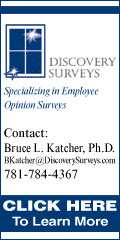NEHRA News
Northeast Human Resources Association
The signs are there. We’ve all seen them, yet so many people choose to ignore the warning lights that are shining brightly in their eyes.
It seems more difficult to be happy at work these days, especially for those who have been given more responsibility without additional pay. Then there is the guilt factor that says you are supposed to be happy because you are gainfully employed in a tough economy.
As the job market loosens, millions of unhappy workers will have to decide whether to remain with their employers or go elsewhere. Here are some signs that the time has come for you to go.
1. You can no longer keep a straight face when the president says, "Our people are our most important asset." It’s impossible to be positive all the time when you are working in HR, but some days are worse than others. Especially when the president follows a statement like this with a layoff announcement. Perhaps the time has come to ensure your name gets on the list, so you can take advantage of any packages that may be offered.
2. Your recommendations are ignored. You used to have the ear of the CEO, but these days she seems to ignore your recommendations. Somewhere along the way your credibility has been lost. Credibility can be reestablished. However, it’s an uphill battle with no guarantees. Maybe it’s time to find a place where your ideas will be valued.
3. You no longer have the energy to do it all. You loved your job so much when you first arrived that it didn’t seem to matter that you were the only manager without administrative support. Now you dread getting out of bed every day because you aren’t sure you’ll have the energy to crawl into bed when you return. Something’s wrong when you are the only one without support. Evaluate where you stand in the organization and prepare to make a change.
4. Outstanding review; underwhelming bonus. It’s been a tough few years for many companies. In spite of the economy, large bonus checks are being cut to others in the organization. Unfortunately, your name isn’t on one of these checks. Read between the lines. You’ve done a great job and can be replaced with someone who will cost a lot less money. If this is the first time this has occurred, you may let it slide. If this is a pattern, then you know exactly what to expect when next year comes along.
5. You no longer have a job. You are working as the lead recruiter for a company that has just instituted a hiring freeze. You’ve been given other tasks to do, but nothing seems to have replaced the adrenaline rush you feel when juggling twenty open requisitions. There are companies adding to staff. Will you retire in place or seek a more active workplace where you can feel alive again?
6. You can’t think of one good thing to say to a new recruit. You used to get excited when you described the company to new recruits. You now find yourself reaching for a script to avoid saying anything negative. Clearly the joy is gone for you. If you can’t say anything nice about the company then perhaps it’s best to say nothing at all. Exit gracefully before you are asked to leave.
7. Your boss asks you to train a "backup". At work, we often hear, "We need someone trained in case you get hit by a bus," even though we rarely hear about people actually being taken out by a bus that has gone wild. This is code for, "You’re on your way out pal. I need you to train someone before I fire you." It’s difficult to stay motivated when you are waiting for the hatchet to fall. Live life on your own terms. Find a new home where you can be happy again.
About the Author:
Roberta Chinsky Matuson is the President of Human Resource Solutions (www.yourhrexperts.com) and author of the highly acclaimed book, Suddenly in Charge: Managing Up, Managing Down, Succeeding All Around (Nicholas Brealey, January 2011). Her firm helps organizations create exceptional workplaces that deliver extraordinary results.
This article uses the story of a failing, but ultimately successful, $180 million offshore outsourcing project to demonstrate how a rigid organization can reap great benefits from a more "nimble" mentality.
Strategic Partnership – The Missing Link
A retail company and a technology service provider recently underwent a turbulent 18-month process to implement a transformational Human Resources (HR) outsourcing initiative. Each side was deeply entrenched in its own view. At its worst, the relationship suffered a contract-threatening standoff that was triggered by consistently sub-standard service levels that resulted in significant monthly financial penalties for the service provider. The relationship was headed towards attorney interventions.
How could this $180 million project be saved? The answer lay in creating a strategic partnership that after only six weeks from the start of the parties’ work achieved 100% service levels – a swift turnaround and a success story in nimbleness.
Separate Agendas Thwart Nimbleness
Significant turnover is all too common during outsourcing engagements, similar to the dynamic in downsizing companies. Employees must regroup when they see colleagues let go and replaced by an outsourced firm halfway around the world. Resentment builds up, creating a greater desire for things to stay the same and sometimes an even greater resistance to change. Outsourcing and downsizing scenarios share this typical pattern.
Our job was to strategically align the Project Management Office (PMO) leadership and purposefully connect the offshore call center operations leads and governance team, all to provide a process for repairing an extremely ineffective relationship. We immediately noticed that both sides had begun the implementation work without first sorting through issues ranging from decision-making and context-setting for individuals new to the project, to the unattended-to emotional strains of having co-workers laid off.
When teams are able to clarify their purpose and the impact of the work, they can begin defining the essence of the work only they can do together. This helps teams strike a balance between critical results and key development needs. The process is something of a see-saw and never perfect, making flexibility and pliability absolutely critical.
Over the course our six-month engagement, we held a series of meetings to guide the parties through the systemic challenges and issues plaguing the business relationship and operational functions. Through our structured five-step process, we worked with various stakeholder constituencies, in order to determine the impact on the customer, the company, and the employees:
1. Define Critical Need (ROI)
2. Stakeholder Clarity
3. Development Game Plan
4. Focus on Right Work
5. Evaluate Results
By shifting the focus to the end state, always thinking with the end user in mind, the teams began to weigh the importance of issues. For example, the end user could be an employee picking up the phone to inquire if their paycheck would arrive in time for a mortgage closing. The team member responding to such a call was guided by the thought, "Will this issue make a difference to our end user?" This nimbleness in thinking quickly allowed major changes to occur.
Nimble Tips + Lessons Learned
- Being nimble requires far greater understanding of the whole system, the ability to handle complexity and the skill to capture the essence of a situation with simplicity -- all while building and maintaining high trust levels.
- Use the "back of the napkin" test to distill the central take-aways for teams. If you can explain the core issues, opportunities or actions on the back of a napkin, you will be far ahead of the pack.
- Continually re-examine the impact of the work and results. Most teams meet weekly or bi–weekly, focusing on the day-to-day. Increase your nimbleness by scheduling monthly half-day meetings that focus only on the strategic work that only your team can do.
- Deal with brutal facts head on, thinking through with your team the implications of those facts and then defining the most critical work.
For most companies, the outsourcing experience ranges from positive (client achieves ROI goals) to negative (client terminates contract). Being flexible allows you to incorporate a strategic partnership approach into a holistic strategy. It’s proven critical to implement a strategic partnership process to prevent client / service provider misalignments, temper unrealistic expectations, and clarify assumptions.
Many leaders underestimate the relationships component of projects characterized by an "us versus them" mentality. This limits the business benefits and returns that a true strategic partnership will encourage throughout an outsourcing engagement. As with any critical initiative, leaders and their teams must be nimble and understand issues beyond the bottom line results.
About the Author:
Laura Stone brings a wealth of strategic consulting and leadership development experience in both start-up and mature business environments as CEO and a senior consultant at Stone + Company. They provide a transformative strategic planning process for clients in the pharmaceutical, manufacturing, retail, insurance, high-tech, and consumer product industries. For more information, visit www.stoneandcompany.com.
The purpose of this study is to obtain information from human resource professionals regarding their experiences, practices, and policies towards these employees. This information is critical for the further development of workplace assistance, referrals, and training to meet the challenges imposed by this devastating illness.
This survey is being conducted by Dr. Carole Cox and Dr. Manoj Pardasani from Fordham University, Graduate School of Social Service, New York. The survey should take approximately 15 minutes, and you will receive a copy of the results that will provide ideas for policies and training associated with the issues that this concern presents.
To participate, click on the link to the survey below:
http://surveymonkey.com/s/TBL6XWY
Thank you for participating in this initiative!
As companies reorganize and reengineer, thousands of people are finding themselves tossed into management every day. People go to bed one evening as a member of the team and wake up the next morning to find themselves managing the team. With training programs going the way of 401(k) match, new managers to fend for themselves. One of the most challenging and critical tasks new managers face is striking a balance between managing down—dealing with employees—and managing up—reporting to bosses. It can now be found on amazon.com .
Congratulations Roberta!
The Community Forums offer:
- Opportunities to network with other NEHRA members on a regular basis
- Opportunities to develop leadership skills
- Opportunities to share useful information and best practices within the Community Forum content area
Currently NEHRA has nine active Forums (click HERE for more info) and is eager to work with members to create more. Specifically we are looking for members interested in helping to form a Benefits Community Forum.
If you have ideas for other Forums and are interested in helping us to pull a group together please contact Carole Edson, Director of Membership, at cedson@nehra.com.
- To become a fan of NEHRA on Facebook, CLICK HERE.
- If you are already a member of LinkedIn, CLICK HERE to join the NEHRA LinkedIn Community!
If you are not already a member of LinkedIn, you will need to follow the easy steps to create your profile. Once your profile is completed you can follow the steps below to become a member of the Northeast Human Resources Group.
- Find the tab for "Groups" on your home page and select "Group Directory."
- Use the search function in the upper right and type in "Northeast Human Resources Association."
- Click on "Join this Group."
- This will bring you to a description of the group and you will be asked to make selections about your preferences for display the group logo on your personal page.
- Enter a contact e-mail address, a digest e-mail address, delivery frequency, announcements and messages.
- Once you have made these choices click the button "Join Group."
- Your message will come to the NEHRA Group Administrator to verify membership and approve you for the group.
To Join a Community Forum Subgroup on LinkedIn
- Once you are a member of the Northeast Human Resources Group, select "Subgroups."
- Select all the groups you are interested in joining.
- Your request goes to the NEHRA Group Administrator for approval.
- You will receive a message that you are a member of this subgroup and you can begin to read and post information on the Subgroup page.
Current NEHRA Subgroups
- Learning and Development Community Forum
- Diversity and Inclusion Community Forum
- Consultants Community Forum
- Small Business HR Community Forum
- HR Technology Community Forum
- Talent Acquisition Community Forum
- Flexible Workplaces Community Forum
As you may know, NEHRA is continuing to evolve to better meet the needs of members. Therefore, we have created a new membership category: Group Membership.
This category is created to recognize the need, and often the desire, of many organizations to control spending and manage membership expenses for their employees.
What does this really mean for you? It means that if your company has five or more current members, you could experience a savings of 10 percent or more on the total cost of these NEHRA memberships through Dec. 31, 2011. In addition, the group membership allows you to renew all memberships at the same time—reducing the hassle and workload of individual renewal dates. Finally—and perhaps most importantly—it ensures that all members of your team have access to programming, to our new webinars, to resources and information at our website and to networking and professional development opportunities.
- How does the program work? All current members from your organization are renewed on a pro-rated basis—based on the individual membership type (NEHRA or NEHRA/SHRM), to bring them to a common renewal date, Dec. 31. Any new members are added and pro-rated, based on a Dec. 31 end date. The entire group is then renewed for another full year, based on this common renewal date.
- Can I add new members? New members can be added to your group at any time during your membership cycle, and their membership will be pro-rated to maintain them on the single renewal date.
- What if someone leaves? You can easily transfer that membership to another employee within your team, with one quick call.
- How does the membership work? Each group member is assigned an individual membership number, allowing them to access information on www.nehra.com and to register for events, webinars and professional development throughout the year.
This is an exciting new opportunity for you to expand access to NEHRA and save money!
If you are interested in learning more about the group membership or getting a quote for your group, please contact Carole Edson, Director of Membership and Alliances, at (781) 239-8705 or cedson@nehra.com.
For more information or to sign up for this opportunity, contact the NEHRA office today at (781) 235-2900 or via email at info@nehra.com.



